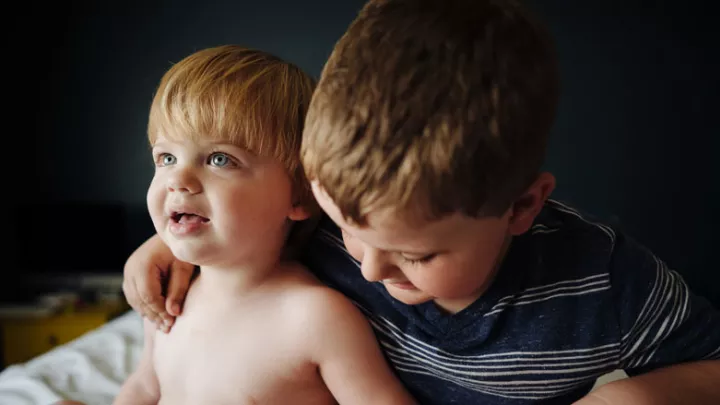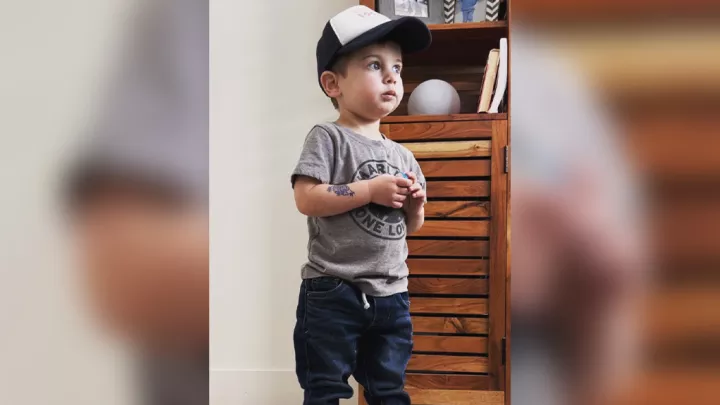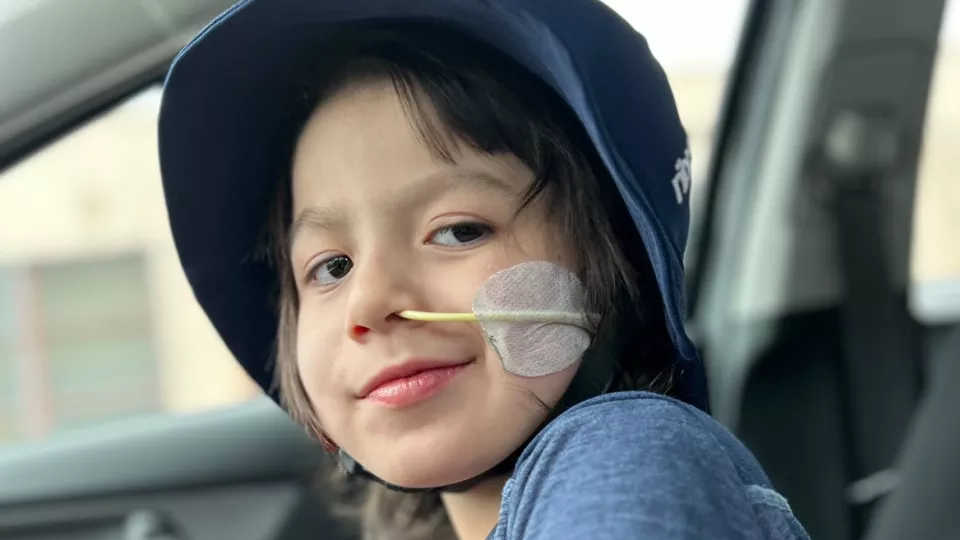
Lifesaving Brain Surgery Rescues Buddy From a Rare Encephalitis
“How can I say yes to someone asking me if I am OK with them cutting my kid’s head open and taking part of his brain out?” Paul asks, emotion clenching his voice. “I didn’t know how to be OK with that.”
But what other option was there? His son, nicknamed Buddy, had been besieged for months by the effects of Rasmussen’s encephalitis, a rare brain disorder that causes inflammation in one half, or hemisphere, of the brain, triggering epileptic seizures that can devastate mental and physical function.

The disease, which generally strikes young children, ravaged the left side of Buddy’s brain. Since its onset in June 2022, when Buddy was 3, the number of seizures would rise and fall, staved off by a pile of medications. But now they were coming virtually uninterrupted—over 150 a day—a potentially fatal condition called status epilepticus that forced Buddy to be admitted to the Pediatric Intensive Care Unit (PICU) at Children’s Hospital Los Angeles with a breathing tube.
“Out of an hour, he was spending 40 minutes either having seizures or recovering from seizures,” CHLA neurologist Latanya Agurs, MD, says, “and he would spend the entire day receiving emergency doses of medications, just to seize over and over again.”
The one effective treatment for Rasmussen’s encephalitis is surgical, but the graphic nature of the procedure, called a hemispherectomy, unnerved Paul and Kristen, Buddy’s mother. Doctors cut away nerve fibers bridging the two halves of the brain so that epilepsy signals cannot travel across—from the side stricken with encephalitis to the healthy side. Removing those connections neutralizes the seizures.
If the surgery worked—as it does 90% of the time—Buddy’s brain would still experience electrical activity that would be picked by an EEG, but he would not feel it, nor could the seizures do him any more harm. In effect, they would be firing blanks.
“If you put an EEG on a person who’s had a disconnection,” Dr. Agurs says, “that EEG’s going to look like he’s having seizures, but I shouldn’t see the patient have any clinical manifestation of them. They’re not spreading from one side of the brain to the other.
“Zero seizures is the operation’s goal,” she says. “Alive and zero seizures. That’s the gold standard.”
When the brain turns on itself
As rare as Rasmussen’s encephalitis is—estimated at 2 cases for every 10 million people—Dr. Agurs, an epileptologist at CHLA’s Neurological Institute, had seen it several times by the time she received Buddy’s case. “I have three or four patients who have it currently,” she says.
“There’s a lot of encephalitis,” she explains. “Rasmussen’s falls into the category of autoimmune encephalitis. Something triggers your cells’ antibodies to attack its own brain, and you can’t always find the reason why.”
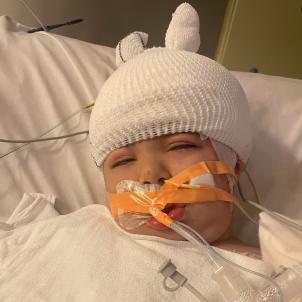
Plus, there’s no stopping it. Agurs says one of the indicators for Rasmussen’s encephalitis is progressive atrophy of the brain, which was visible on Buddy’s imaging.
“You get two MRIs three months apart and you’re thinking, ‘Why is the brain smaller?’ It had already happened. He’d had some brain shrinkage already.”
He exhibited the telltale motor deficits of brain degeneration, which are typically experienced on the opposite side of where the seizures occur. So it was with Buddy. The strength in his right leg declined to where he could no longer stand upright.
“He was stumbling everywhere,” Kristen says. “He couldn’t hold his balance.”
His language ability worsened as well. Independent of the encephalitis, Buddy suffered from autism, limiting his speech to one-word sentences, which now came out in a slurred slow motion.
CHLA neurosurgeon Jason Chu, MD, MSc, says Rasmussen’s encephalitis needs to be acted upon early before it erodes so much of a child’s brain that the brain’s growth is stunted and may even regress. Importantly, a central trait of a young child’s brain is its neuroplasticity—a limberness that allows the brain to adapt to a new weakness and gradually autocorrect, as the healthy areas take on the work of the injured part.
“As we get older, our brain starts to solidify in very specific areas,” Dr. Chu says. “But in younger patients, the good side can actually pick up a lot of the functions from the diseased side.”
Disabling the pathways
Disconnecting the brain’s two hemispheres, however, has “trade-offs,” Dr. Chu says. He explained to the family that the procedure would bear significant physical and mental impairments, and a need for extensive therapy to restore those areas. One consequence of the procedure that could not be recovered would be the loss of his right field of vision, opposite where the nerve fibers would be cut.
“That’s a very difficult conversation to have and can be very scary for families,” Dr. Chu says. “But we’re talking about an operation that has a really high chance of curing the epilepsy—never having a seizure again for the rest of your life.”
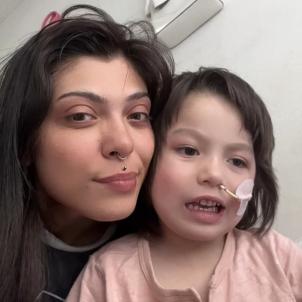
Kristen quickly gave her approval for the surgery, looking toward the recovery. “Let’s get it over with so we can work on the deficits post-op,” she recalls thinking. “I want to get my son back.”
But she shared Paul’s fears. “It’s brain surgery. What if they don’t cut enough? What if they cut too much? What if they cut in the wrong spot, and what if my son doesn’t come out of it?”
Meanwhile, Paul read up on Rasmussen’s encephalitis. He overcame his reluctance after he learned what “a monster” the disease is, he says. “I still have Google tabs open right now on my laptop from back when I was looking up the condition. I didn’t want to feel selfish. I didn’t want to be the reason he didn’t get better.”
The experience of their doctors reassured them both, the result of working in a Level 4 epilepsy center, the highest designation of expertise awarded to a hospital. “They sat us down and said, ‘This is not the first time we’ve seen this,’” Kristen says. “Dr. Chu was like, ‘I just did this surgery not too long ago. You’re the third patient to come into the PICU with Rasmussen’s encephalitis.’”
The hemispherectomy was performed Oct. 7, 2022. Scheduled for 12 hours, it went 13—a surgeon’s dozen. Dr. Chu and his team removed all the connections between the two halves of Buddy’s brain, preventing the left side from transmitting seizures over to the right.
“If you leave anything connected, seizures will still get across and you will have wasted your time,” Dr. Agurs says.
Paul describes the outcome succinctly: “They went in and cut my kid’s brain in half and saved his life.”
An unexpected gesture
For the first weeks after the procedure, Buddy did not talk, nor could he move the right half of his body. But Dr. Chu had warned of this outcome beforehand and said the deficits would not last.
“He gave us the rundown,” Kristen says. “‘This is what you need to expect coming out of surgery. It’s going to take him a while to get back up, but just be there for him, continue doing what you’re doing, and he’ll be OK.’”
So it was, as after a month Buddy’s speech returned. “Not full sentences, but he was saying his one-word phrases again,” Kristen says.
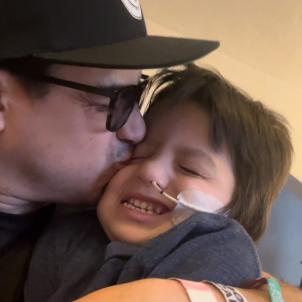
Fifteen months since, Buddy’s progress is dramatic. As was hoped, the plasticity of his young brain has worked in his favor, the right side seeming to absorb what had been the tasks of the left—and in Dr. Agurs’ view, at a much higher level.
“After doing his assessment, we assumed that his language has moved itself over,” she says. “Seeing him in clinic now, I think his language and his ability to communicate have gotten vastly better since his surgery. He’s much more verbal than he was.”
And certainly more blunt. “A couple of days ago,” Kristen says, “he was watching TV and I went to play with him, and he says, ‘Hey, I can’t see.’ So he’s speaking clearly now.”
Physically, Buddy has also adapted. A natural righty, he has learned to be left-handed. He limps and wears leg braces, but they don’t conceal his recovery. Asked if he’s walking, Kristen goes one better: “He’s running.”
Dr. Agurs and Dr. Chu marvel at his improvement, having watched Buddy march around the clinic in October. “He couldn’t even stand on his own last year when he was having seizures,” she says. “A lot of things recover really well after a hemispherectomy, especially when you’re under the age of 6.”
The most important post-op finding, of course, was the immediate and complete elimination of Buddy’s seizures. The doctors don’t expect them to return. But Kristen can’t keep from reacting to the smallest sudden gesture.
“As happy and hopeful as I am, I always have that doubt in the back of my mind,” she says. “That feeling never goes away. Say he twitches in his sleep or does any little movement, I still flinch. I’m day to day, and I don’t think that’ll ever change.”
There was one unexpected gesture that brought not anxiety, but instead astonishment and joy. One day while on a drive, Paul told his son that he loved him, and Buddy answered back with a complete sentence he had never said before: “I love you.”
“I don’t know why he said it back,” Paul says. “Maybe he just felt safe and comfortable.”
When Dr. Agurs heard about it later, it moved her to tears.
“I always feel so bad for Paul,” she says, noting Paul’s regret over initially delaying the surgery. “He always says, ‘I shouldn’t have waited.’ I told him, ‘It’s OK. We got it done, right? We got it done.’”
